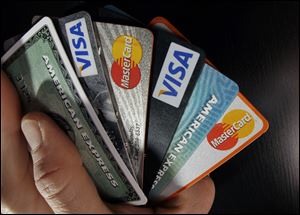
Credit card debt down in Ohio, Michigan
2006-2015 data collected show states at top of list
3/21/2017
Consumers nationwide cut their credit card debt significantly between 2006 and 2015, but no states saw a bigger drop than Ohio and Michigan.
Consumers nationwide cut their credit card debt significantly between 2006 and 2015, but no states saw a bigger drop than Ohio and Michigan.
The two states were at the top of a list recently compiled by New York-based financial website SmartAsset, which has examined the relationship between income and credit card debt.
It said Michigan consumers cut their credit card debt-to-income ratio by 32.9 percent from 2005 to 2011, and another 21.5 percent from 2011 to 2015. As of 2015, the average debt-to-income ratio was 9 percent.
In Ohio, consumers cut their credit card debt-to-income ratio by 31.7 percent from 2005 to 2011 and another 24.5 percent from 2011 to 2015 when the debt-to-income ratio was 9.3 percent.
Average credit card debt over that period fell 33 percent in Michigan to $2,350 and fell by 30 percent in Ohio to $2,480. After the leaders, other states whose residents had the fastest decline in credit card debt were West Virginia, Colorado, North Carolina, Wisconsin, Montana, Iowa, North Dakota, and Utah.
SmartAsset said the change may have had to do with an unwillingness to take on credit card debt in an uncertain economy.
James Bell, an official at Fifth Third Bank, which has branches in Ohio and Michigan, said the findings generally mirror what the bank has seen.
“On the face of it, it definitely looks like consumers are being more deliberate in their approach to building debt, and it also looks like we’re continuing on a path of relatively low delinquencies, both of which are positive indicators,” he said.
Even so, part of the reason that credit card debt fell during the Great Recession likely was people filing for personal bankruptcies, which can wipe away credit card debt. Mr. Bell said some card issuers also were lowering borrowing limits during that time, which cut how much debt a person could rack up.
After peaking in 2008, credit card debt declined through 2014, SmartAsset said. But it’s starting to go back up.
Mr. Bell said that makes sense, as an improving economy has banks willing to lend and consumers spending.
“What you’re seeing gradual expansion of consumer credit card debt is a reflection of the economy improving and customers becoming more optimistic about the mid to long term prospects for the economy,” he said.
Mr. Bell said there’s no golden number when it comes to credit card debt-to-income ratios. He said to pay on time in full every month.
When consumers are carrying debt from month to month, Mr. Bell recommended keeping to a plan.
“Credit cards are an incredibly important tool when used wisely, and they do give consumers an ability to pay over time, whether it’s an emergency expense or a large investment in the home,” he said. “It’s just really important when you make those uses of a revolving credit facility you make a budget and keep to that budget.”
Contact Tyrel Linkhorn at tlinkhorn@theblade.com or 419-724-6134.